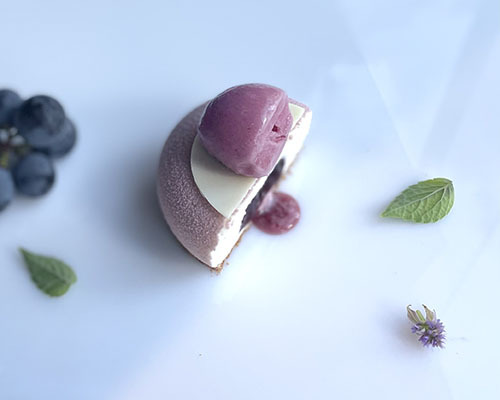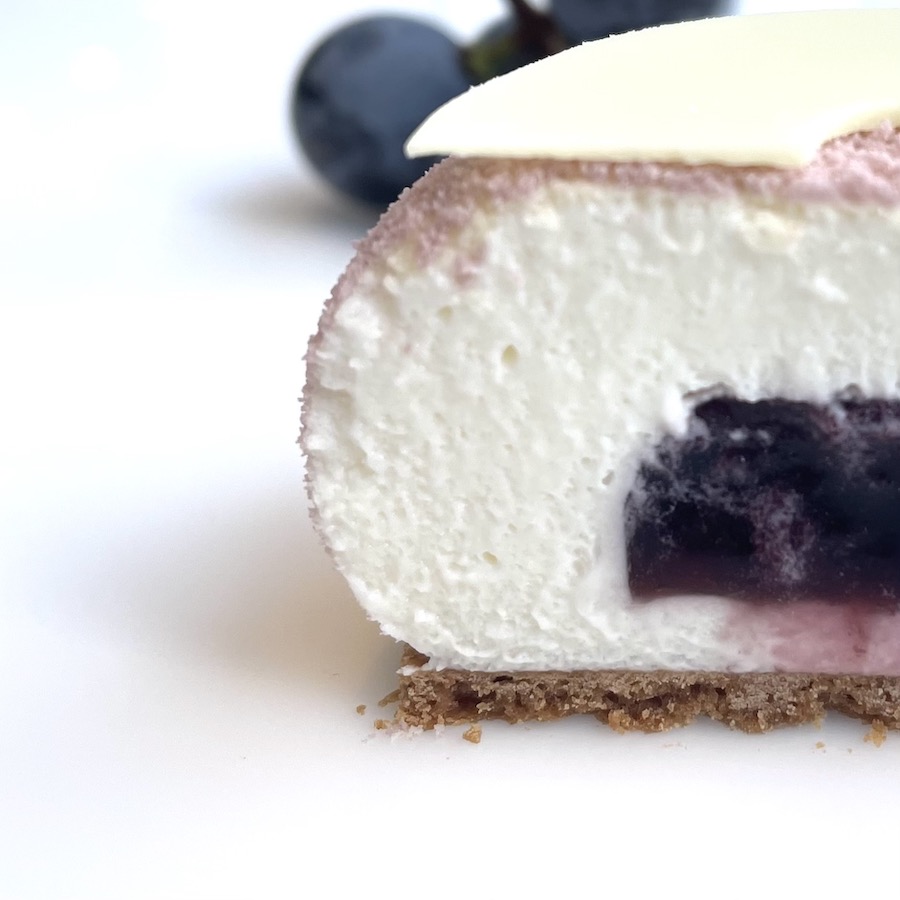In my mind, nothing marks the transition from summer to fall quite like Concord grapes.
Just as the crisp chill in the air, the slow retreat of daylight hours and the subtle turn of the foliage all signal the arrival of autumn, there are flavors that also reflect the shift of the seasons.
While apple, pear, quince — and, yes, pumpkin — will eventually fill out seasonal dessert menus for the months to come, the appearance of the Concord grape is a bit more fleeting.

It’s easy to argue that most of what we call ‘table’ grapes that are available year-round — whether red or green — don’t pack much of a punch in the flavor department. That’s why the late September arrival of plump purple Concords make for a sweet, tart and juicy welcome as summer berry season fades into memory. This is the essence of ‘grape’ flavor we associate with everything from jelly and juice to candy and soda.
This is the essence of ‘grape’ flavor we associate with everything from jelly and juice to candy and soda.
Pastry chefs tend stock up on these intense flavor bombs when in season and are often fashioned into desserts that draw from a subtle sense of nostalgia.
More Recipes: Chef Penny's Concord Grape Tart
The Concord grape is a unique variety bred from native North American grapes, notably the wild Vitis labrusca. Its origin dates to 1849, after an intensive trial led by Ephraim Wales Bull on his farm in Concord, Massachusetts. The new grape hit Northeastern markets in 1854, quickly gaining favor, winning awards and earning a reputation abroad. It is said that cuttings from Bull’s original vines fetched upwards of $1,000.
The Concord enjoyed increased popularity in the next decade, when Dr. Thomas Welch began producing an unfermented grape juice utilizing the recently developed concept of pasteurization. By 1900, Welch’s fledgling juice empire was processing 300 tons of grapes a year. The union of grape jelly and peanut butter that would become a school lunch staple began to gain traction in the 1920s.
Today, over 300,000 tons of Concord grapes are grown each year in the United States. New York is second in production, just behind Washington State.
Crafting Concords into components sweet or savory requires some degree of effort. Hidden under the thick “slip-skins” and juicy pulp are hard stubborn seeds that must be removed. Crushing the grapes or buzzing them in a blender is simple enough; the real chore ends up being the patient passing through a sieve or cheesecloth to produce a skin and seed-free pulp.
The reward is worth the rigor. One might stumble upon a seedless Concord now and then, but I almost see the requisite crush-and-strain exercise as a comforting ritual of the season. Beware, however, that the errant drops of juice instantly leave behind a dark purple (and near permanent) stain.

With this year’s crop, I’m seeking to rework and refine a classic dessert — cheesecake — with a seasonal punch-up of Concord grape.
A light cream cheese mousse spiked with a touch of lemon fills in for the rich and dense texture of traditional cheesecake. The pillow of mousse is set on a Graham cracker sablée and concealed in its center is a core of liquid Concord grape. The whole is sprayed with a thin, velvety layer of white chocolate and accompanied by a grape sorbet.

Ingredients
For the Concord Grape Coulis
- 150 grams Concord grape juice
- ½ gelatin sheet, hydrated
- 25 grams invert sugar
- (Total weight: approximately 180 grams)
For the Cheesecake Mousse
- 3 sheets gelatin
- 50 grams cold water
- 110 grams sucrose
- 1 gram salt
- 100 grams unsalted butter, softened
- 225 grams cream cheese, softened
- 60 grams crème fraiche
- 40 grams lemon juice
- 300 grams heavy cream (36% fat)
- (Total weight: 885 grams)
For the Graham Cracker Sablée:
- 80 grams unsalted butter
- 125 grams graham cracker crumbs, finely ground
- 13 grams potato starch
- 80 grams confectioners’ sugar
- 2 grams salt
- 75 grams egg whites
- 90 grams all-purpose flour
- (Total weight: 465 grams)
For the Concord Grape Sorbet:
- 10 grams sucrose (1)
- 2 grams sorbet stabilizer
- 95 grams water
- 55 grams sucrose (2)
- 25 grams glucose powder
- 10 grams dextrose
- 5 grams invert sugar
- 250 grams Concord grape juice
- (Total weight: 450 grams)
For the White Chocolate Spray:
- 250 grams white chocolate, melted
- 250 grams cocoa butter, melted
- Purple colorant (fat soluble), as needed
For Assembly:
- White chocolate decor
Directions
For the Concord Grape Coulis:
- Place the grape juice in a saucepan. Gently bring to a simmer and remove from heat.
- Whisk in the gelatin and invert sugar. Deposit the mixture into 3cm silicon hemisphere molds and freeze to set.
For the Cheesecake Mousse:
- Hydrate the gelatin in the full measurement of water. Gently heat to dissolve and reserve.
- In the bowl of a stand mixer fitted with a paddle attachment, combine the sucrose, salt and butter, creaming the mixture well. Slowly add the cream cheese, occasionally scraping down the sides of the bowl. Follow with the addition of the crème fraiche, lemon juice and dissolved gelatin.
- Fold in the whipped cream and deposit into 70cm silicone ‘stone’ molds; insert into each one of the frozen half-spheres of Concord grape coulis. Top with additional mousse as needed, level and then freeze.
For the Graham Cracker Sablée:
- Combine the butter, graham cracker, starch, confectioner’s sugar and salt in a food processor and pulse until combined. Add the egg whites and continue blending until incorporated.
- Transfer the mixture to a mixing bowl and stir in the flour by hand.
- Sheet the dough between two half sheet-sized pieces of acetate and freeze.
- Transfer the dough between two silicon baking mats set on a flat pan. Bake at 150°C/300°F just until set, 5-7 minutes; remove the pan from the oven and cut 75mm discs. Return to the oven to continue baking until lightly browned, 8-10 minutes.
For the Concord Grape Sorbet:
- Combine the first measurement of sucrose and stabilizer. Reserve.
- In a saucepan, heat the water to 50°C/120°F. Whisk in the stabilizer mixture, the second measurement of sucrose, glucose powder, dextrose and invert sugar. Bring just to a boil and remove from heat.
- Chill and allow the syrup to mature at least 4 hours.
- Combine the juice and syrup and process in a batch freezer; extract the mix at -5˚C/23˚F. Alternatively, transfer to PacoJet canisters and freeze; process as needed. Continue to harden the sorbet at -18˚C/0˚F as necessary.
For the White Chocolate Spray:
- Combine the white chocolate, cocoa butter and desired color and transfer to an airbrush or paint sprayer and apply a thin layer onto the frozen and unmolded portions of cheesecake mousse. Return to freezer until ready to serve.
For Assembly:
- Remove the portions of cheesecake mousse from the freezer and set onto discs of the baked graham cracker sablée. Allow to temper under refrigeration.
- When ready to serve, plate the cheesecake mousse, top with white chocolate decor, and finish with a small scoop or quenelle of Concord grape sorbet.
Ready for more fall recipes? Check out Chef Barry's fall vegetable recipes and read his advice on how to make the most of the season's bountiful produce.




